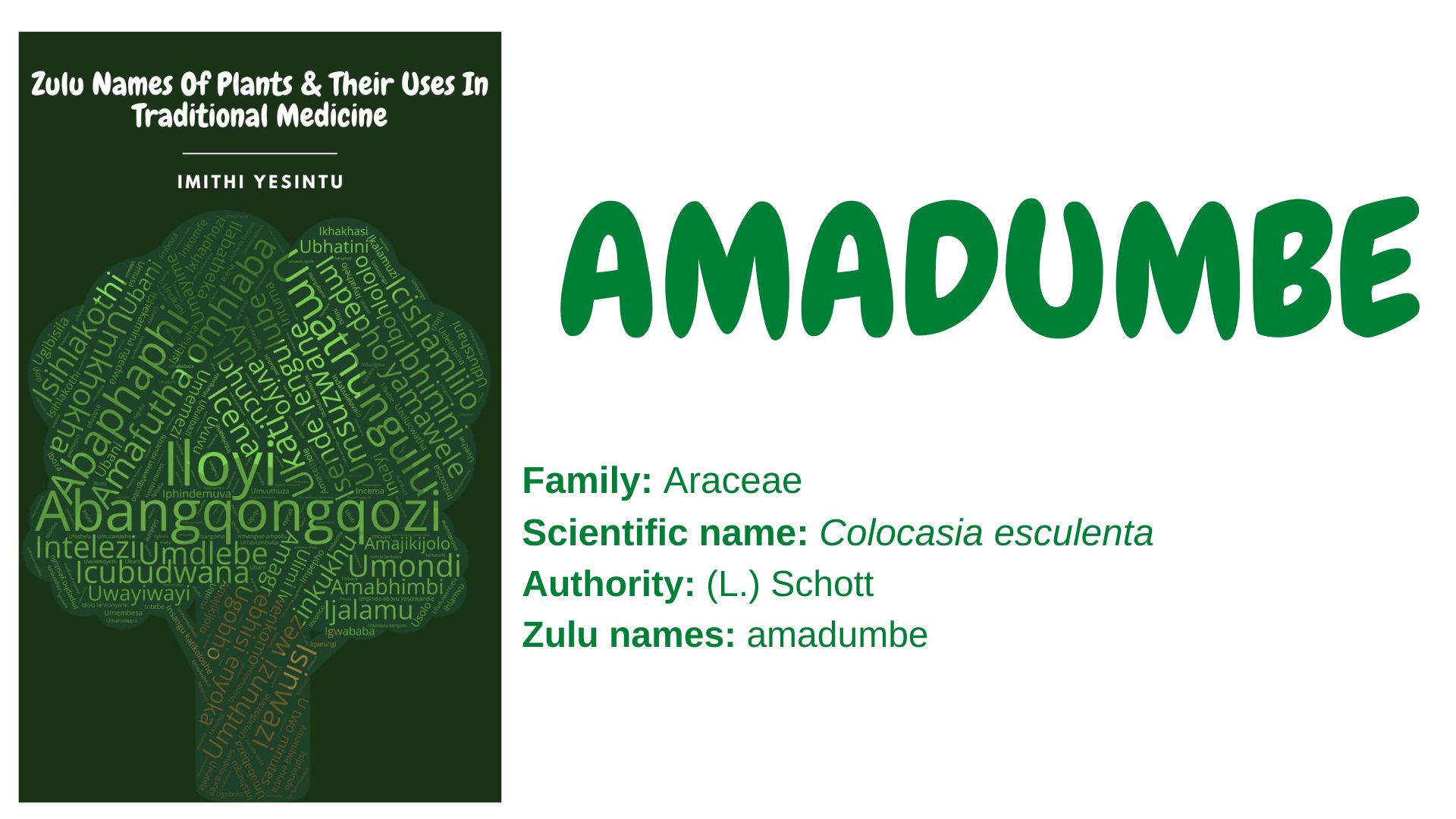Family: Araceae
Scientific name: Colocasia esculenta
Authority: (L.) Schott.
Synonyms: Colocasia esculenta f. rotundifolia, Leucocasia esculenta (L.) Nakai
Zulu name: amadumbe
Other names: elephant’s ear, white cocoyam, taro, taro potatao
Plant description: C. esculenta is a tuberous herb with large heart-shaped leaves, yellowish-green flowers, small berry fruits, and nutrient-rich root-like corm with white flesh. The plant is cultivated as a crop by small farmers in the coastal and subtropical regions of South Africa.
The plant’s leaves and corm are poisonous if eaten raw, due to the acrid calcium oxalate they contain. Cooking the plant destroys the poison. If the plant is ingested raw, it can cause stomach ache.
Uses:
- The corm is cooked and eaten as food, like potatoes.
- The corm is dried and pounded to make flour.
- The flour is used to make baby food for children sensitive to milk.
- The leaves are cooked and eaten as a leafy green.
- The juice obtained from the leaves is used to treat snake bites and food poisoning.
- The leaf juice is used as a hepatoprotective, to treat acute and chronic liver diseases
- The plant is used to treat digestive and metabolic problems.
- The plant is used to treat fever and cardiovascular disorders.
Safety precaution:
Using traditional medicine responsibly can enhance your overall health and well-being. Misuse and abuse can lead to complications. You can inquire about the correct use of traditional medicine from a knowledgeable herbalist and practitioner. You can also visit imithiyesintu.co.za or email: info@imithiyesintu.co.za to learn more about traditional medicine
References and further reading:
- Greyling, M.M., Jansen van Rensburg, W.S. and Shanahan, P., 2011, June. Molecular characterization of South African taro (Colocasia esculenta) germplasm using SSR markers. In II International Symposium on Underutilized Plant Species: Crops for the Future-Beyond Food Security 979 (pp. 459-466).
- Mabhaudhi, T. and Modi, A.T., 2015. Drought tolerance of selected South African taro (Colocasia esculenta L. Schott) landraces. Experimental Agriculture, 51(3), pp.451-466.
- Patil, B.R. and Ageely, H.M., 2011. Antihepatotoxic activity of Colocasia esculenta leaf juice. International Journal of Advanced Biotechnology and Research, 2(2), pp.296-304.
- Rashmi, D.R., Raghu, N., Gopenath, T.S., Palanisamy, P., Bakthavatchalam, P., Karthikeyan, M., Gnanasekaran, A., Ranjith, M.S., Chandrashekrappa, G.K. and Basalingappa, K.M., 2018. Taro (Colocasia esculenta): an overview. Journal of Medicinal Plants Studies, 6(4), pp.156-161.
- Reyad-ul-Ferdous, M., Arman, M.S.I., Tanvir, M.M.I., Sumi, S., Siddique, K.M.M.R., Billah, M.M. and Islam, M.S., 2015. Biologically potential for pharmacologicals and phytochemicals of medicinal plants of Colocasia esculenta: A comprehensive review. American Journal of Clinical and Experimental Medicine, 3(5-1), pp.7-11.
- Williams, R., Pelser, D. and Black, V. eds., 2018. Agroecology is best practice. Biowatch South Africa’s work with smallholder farmers.
You Can Order Your Copy Of The Book By Emailing: info@imithiyesintu.co.za
Feel Free To Add Other Uses Of This Plant In The Comment Section Below:
